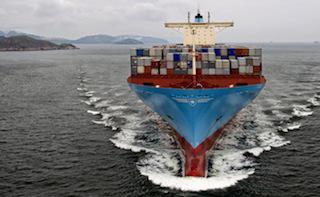Liners plan more rate hikes to halt renewed container spot rates decline
After last week’s hiatus, container spot freight rates on the Asia-Europe trades resumed their downward trajectory this week, with prices to both North Europe and Mediterranean ports falling.
The World Container Index (WCI) produced by Drewry, which quotes prices paid over the week, showed rates on the Shanghai-Rotterdam leg down by 5% week on week, to $2,512 per 40ft, as the effects of carriers’ 1 March FAK hikes wore off.
Spot rates on the leg are now some 28% below the same point last year, according to the WCI, and lower than the post-Chinese New Year and Golden Week pricing slumps last year.
Meanwhile, the WCI’s Shanghai-Genoa leg declined 11% week on week, to end at $3,333 per 40ft.
However, spot rate declines on both trades have occurred against a backdrop of relatively strong demand.
According to recently released figures from Container Trade Statistics (CTS), January saw 1.5m teu shipped from the Far East to Europe, an 18.2% increase in volumes over January 2024.
This implies that rising capacity on the trade is outpacing growth, leading to falling vessel utilisation levels, suggested Sea-Intelligence chief executive Alan Murphy.
“On Asia-Europe, utilisation at a monthly level dropped in January 2025, whereas this drop typically only begins after Chinese New Year.
“This is likely a part of the explanation for the early drop in spot rates on this tradelane in January,” he added.
Several carriers have now published new FAK rate levels for implementation on 1 April to arrest the declines. Both Hapag-Lloyd and MSC have set the new FAK rate at $4,000 per 40ft between the Far East and North Europe.
Meanwhile, expectations are that next week will show further declines.
Today’s Shanghai Containerised Freight Index (SCFI), which aggregates spot freight quotes for the forthcoming week, showed a 15% week-on-week decline in China-North Europe rates, and an 8% decline in China-Mediterranean pricing.
“On Asia-North America, there is a clear strengthening of utilisation in January. This trade also saw spot rates hold firm longer than in Asia-Europe, lending credence to the notion that lower utilisation is one of the drivers behind the early drop in Asia-Europe spot rates,” Mr Murphy explained.
However, spot rates continued to fall on the transpacific and Asia-US east coast trades this week. The WCI’s Shanghai-Los Angeles leg finished at $2,906 per 40ft, an 8% week-on-week drop, while the Shanghai-New York trades was down 7% week on week, to finish at $4,038 per 40ft.
Today’s SCFI points to further declines next week, with its US west coast leg down 14% and the east coast leg down 10%.
However, one silver lining for carriers is that backhaul rates may have found their floor, with the WCI’s Rotterdam-Shanghai leg up 1% week on week, to $490 per 40ft, and New York-Shanghai also up 1%, to 854 per 40ft.
These marginal increases have come despite some pretty poor volume data – CTS recorded January Europe-Far East volumes at 484,000 teu, 3.1% down year on year, while North America-Far East shipments were down 9.6% year on year, to 473,100 teu.
In contrast, the transatlantic trade had a robust January in terms of volumes – the headhaul Europe-North America route saw a 10.8% year-on-year gain to 495,000 teu, and the WCI’s Rotterdam-New York leg was up 1% week on week, to $2,373 per 40ft, despite a growing imbalance between demand and supply, which could affect rates in the next few weeks.
“On Europe-North America however, there was a sharp drop in utilisation in January, but curiously, without a major drop in spot rates – at least not yet,” Mr Murphy said.
“The transatlantic is a special animal, not subject to the “normal” market dynamics, but it can’t stay out of sync with supply/demand for too long, so we expect a serious downwards correction in the coming weeks/months,” he added.

